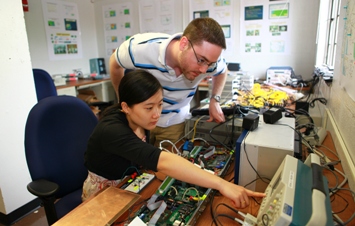New Engineering Research Center to Make Electricity Transmission More Reliable, Secure, and Efficient

CURENT ERC researchers will create better technologies for the electric power transmission system.
August 17, 2011
The National Science Foundation (NSF) announced an award to the University of Tennessee, Knoxville, and its partners to establish a new Engineering Research Center (ERC) jointly funded by NSF and the Department of Energy (DOE): the NSF-DOE ERC for Ultra-wide-area Resilient Electric Energy Transmission Network (CURENT). CURENT will develop interdisciplinary research and education programs that address the nation's electrical grid infrastructure system and provide the foundation for new industries through innovation. Over the next five years, the NSF ERC program and the DOE Office of Electricity Delivery and Energy Reliability together will invest $18.5 million in the Center.
The transmission network is the backbone of the electrical infrastructure that powers the country's businesses and homes. Thousands of miles of high-voltage transmission lines connect hundreds of electricity generation sources. This aging system, however, is poorly equipped to respond to growing electricity demand, renewable electricity sources such as wind and sunlight, and unanticipated events.
CURENT researchers will pursue strategies that allow more reliable, secure, and efficient operation of the electricity transmission infrastructure across vast distances. With the help of simulations on high-performance computers, their transforming technologies will employ advanced measurement and communications along with more robust control strategies and faster response times. CURENT's contributions will enable a more intelligent, resilient electrical grid that accepts more renewable energy sources.
CURENT will be based at the University of Tennessee, Knoxville, and will have three university partners in the U.S.: Northeastern University, Rensselaer Polytechnic Institute, and Tuskegee University. Researchers at the National Technical University of Athens in Greece, Tsinghua University in China, and the University of Waterloo in Canada will contribute additional expertise and international perspectives.
More than 40 industry partners, which range from small start-up firms to manufacturers to utility companies, will guide strategic planning, spur innovation, and provide university students with first-hand experience in entrepreneurship. CURENT will also work with three regional organizations -- Southwest Research Institute, Technology 2020, and the University of Tennessee Research Foundation -- to stimulate technology transfer.
The CURENT ERC award marks the first time that the NSF investment in an ERC will be matched by another federal agency, DOE. "Through this partnership, as with partnerships between NSF and industry, we bring together complementary strategic objectives," said Thomas Peterson, the NSF Assistant Director for Engineering. "Jointly-funded ERCs will have unique opportunities to advance basic and translational research and to shape the energy workforce-all of which will be essential for energy innovation."
Since 1985 the NSF ERC program has fostered broad-based research and education collaborations to focus on creating technological breakthroughs for new products and services and on preparing U.S. engineering graduates to successfully participate in the global economy. The four centers launched this June, as part of the third generation of NSF ERCs, place increased emphasis on innovation and entrepreneurship, partnerships with small research firms, and international collaboration and cultural exchange.
"The Gen-3 ERCs are designed to speed the process of transitioning knowledge into innovation and to provide young engineers with experience in research and entrepreneurship to strengthen their role as innovation leaders in the global economy," said Lynn Preston, the leader of the ERC Program. "Building on the rich understanding we gained from two previous generations of ERCs, we expect these new centers to make even more significant impacts on the competitiveness of U.S. industry."
-Cecile J. Gonzalez, NSF, cjgonzalez@nsf.gov-
Media Contacts
Joshua A. Chamot, NSF, (703) 292-7730, jchamot@nsf.gov
DOE Public Affairs, (202) 586-4940
Margie Nichols, University of Tennessee, Knoxville, (865) 974-3309, mnichols@utk.edu
Program Contacts
Lynn Preston, NSF, (703) 292-5358, lpreston@nsf.gov
Barbara Kenny, NSF, (703) 292-4667, bkenny@nsf.gov
Philip Overholt, DOE Office of Electricity Delivery and Energy Reliability, (202) 586-8110, Philip.Overholt@hq.doe.gov
Principal Investigator
Kevin Tomsovic, University of Tennessee, Knoxville, (865) 974-3461, tomsovic@tennessee.edu
Related Websites
NSF ERC for Ultra-wide-area Resilient Electric Energy Transmission Network (CURENT): http://curent.utk.edu
NSF ERC Program: http://www.erc-assoc.org
DOE Office of Electricity Delivery and Energy Reliability: http://www.oe.energy.gov
The U.S. National Science Foundation propels the nation forward by advancing fundamental research in all fields of science and engineering. NSF supports research and people by providing facilities, instruments and funding to support their ingenuity and sustain the U.S. as a global leader in research and innovation. With a fiscal year 2023 budget of $9.5 billion, NSF funds reach all 50 states through grants to nearly 2,000 colleges, universities and institutions. Each year, NSF receives more than 40,000 competitive proposals and makes about 11,000 new awards. Those awards include support for cooperative research with industry, Arctic and Antarctic research and operations, and U.S. participation in international scientific efforts.
Connect with us online
NSF website: nsf.gov
NSF News: nsf.gov/news
For News Media: nsf.gov/news/newsroom
Statistics: nsf.gov/statistics/
Awards database: nsf.gov/awardsearch/
Follow us on social
Twitter: twitter.com/NSF
Facebook: facebook.com/US.NSF
Instagram: instagram.com/nsfgov


